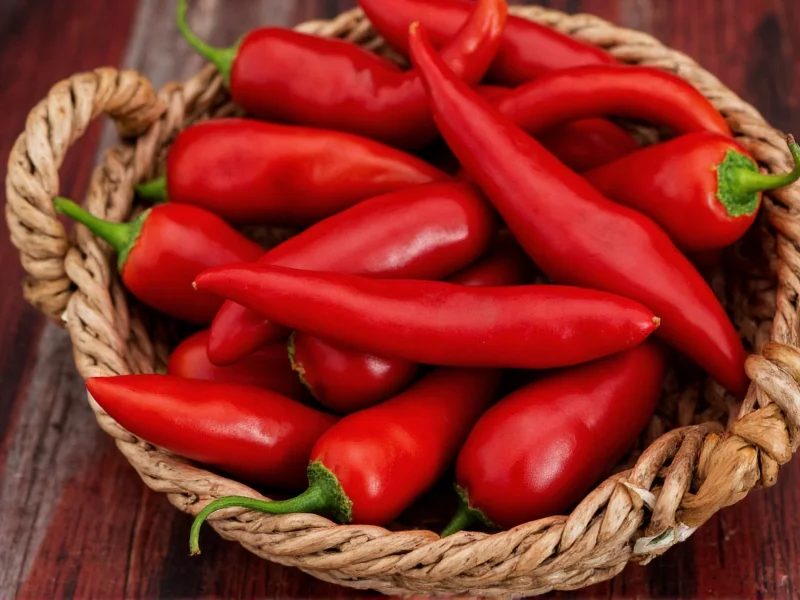Understanding the precise Scoville rating of red jalapeños helps home cooks and culinary professionals select appropriate peppers for their recipes. The Scoville scale, developed by pharmacist Wilbur Scoville in 1912, measures the concentration of capsaicinoids—the compounds responsible for a pepper's heat—in Scoville Heat Units.
Red Jalapeño Heat Profile Explained
When jalapeños mature and change from green to vibrant red, their chemical composition shifts. This ripening process affects both flavor and heat characteristics. Contrary to popular belief, red jalapeños aren't necessarily hotter than their green counterparts—both varieties fall within the same 2,500-8,000 SHU range. However, fully ripened red jalapeños often develop more complex flavor notes with subtle sweetness that can make the heat feel less intense.
The actual heat level of any specific red jalapeño depends on several factors including growing conditions, soil composition, water availability, and even the position of the pepper on the plant. Stressors like drought or nutrient deficiency can cause peppers to produce more capsaicin, resulting in hotter specimens.
Red vs Green Jalapeño Heat Comparison
| Pepper Type | Scoville Range | Flavor Profile | Best Culinary Uses |
|---|---|---|---|
| Red Jalapeño (fully ripe) | 2,500-8,000 SHU | Sweeter, fruitier, more complex | Salsas, sauces, roasting, drying |
| Green Jalapeño (unripe) | 2,500-8,000 SHU | Grassy, vegetal, brighter heat | Popper recipes, fresh salsas, pickling |
| Chipotle (smoked red jalapeño) | 2,500-8,000 SHU | Smoky, earthy, deep flavor | Barbecue sauces, stews, marinades |
Factors Influencing Red Jalapeño Heat Levels
Several variables affect the final heat measurement of red jalapeños:
- Ripeness: Fully mature red jalapeños may develop slightly more capsaicin than when green, but the difference is usually minimal within the same plant
- Environmental stress: Drought conditions or temperature extremes can increase capsaicin production
- Genetic variation: Different jalapeño cultivars naturally produce varying heat levels
- Plant position: Peppers growing in direct sunlight often develop more heat than shaded ones
- Seed and membrane content: The white pith and seeds contain most capsaicin—removing these reduces perceived heat
How Red Jalapeños Compare to Other Common Peppers
Understanding where red jalapeños fall on the broader Scoville scale provides context for their heat level:
- Bell peppers: 0 SHU (no heat)
- Poblano: 1,000-2,000 SHU (milder than jalapeños)
- Serrano: 10,000-23,000 SHU (2-3 times hotter than jalapeños)
- Habanero: 100,000-350,000 SHU (up to 40 times hotter)
- Ghost pepper: 855,000-1,041,427 SHU (over 100 times hotter)
This comparison shows that red jalapeños occupy a versatile middle ground—hot enough to provide noticeable heat but mild enough for most palates. Their position makes them ideal for introducing people to spicy foods or for recipes where you want flavor with moderate heat.
Culinary Applications Based on Heat Level
The moderate heat of red jalapeños makes them incredibly versatile in the kitchen. Their ripened state brings out sweeter flavor notes that work well in:
- Sauces and salsas: Roasted red jalapeños create rich, complex sauces with balanced heat
- Drying: Fully ripe red jalapeños dry into chipotles (when smoked) or chiles secos, concentrating their flavor
- Infused oils: Their moderate heat infuses beautifully into oils without overwhelming
- Stuffed peppers: The thicker walls of ripe jalapeños hold fillings better
- Pickling: Red jalapeños maintain their vibrant color when pickled
When substituting red jalapeños in recipes calling for green, remember that the flavor profile differs even if the heat level remains similar. The sweetness of red jalapeños complements fruit-based salsas and chocolate-infused dishes particularly well.
Growing Tips for Controlling Heat
If you're growing your own jalapeños and want to influence their heat level:
- For milder peppers: Maintain consistent watering and avoid environmental stress
- For hotter peppers: Allow slight drought stress before harvest
- Harvest timing: Fully red peppers may have slightly more developed capsaicin
- Soil composition: Higher potassium levels can increase capsaicin production
- Leave peppers on the plant longer for maximum ripeness and flavor development
Safety Considerations When Handling Hot Peppers
Even at their moderate heat level, red jalapeños contain enough capsaicin to cause skin and eye irritation. Always:
- Wear gloves when handling large quantities
- Avoid touching your face while preparing peppers
- Wash hands thoroughly with soap after handling
- Remove seeds and white membranes for reduced heat
- Have dairy products nearby to counteract excessive heat (milk, yogurt, sour cream)
Measuring Heat Accurately
While the Scoville scale provides a general reference, actual heat perception varies by individual. Modern high-performance liquid chromatography (HPLC) provides more precise capsaicin measurements than the original human-tasting Scoville method. This explains why two red jalapeños from the same plant might register differently on the Scoville scale.
When following recipes that specify heat levels, consider your personal tolerance and the specific peppers you're using. The same red jalapeño might taste significantly hotter to one person than another based on individual capsaicin sensitivity.











 浙公网安备
33010002000092号
浙公网安备
33010002000092号 浙B2-20120091-4
浙B2-20120091-4